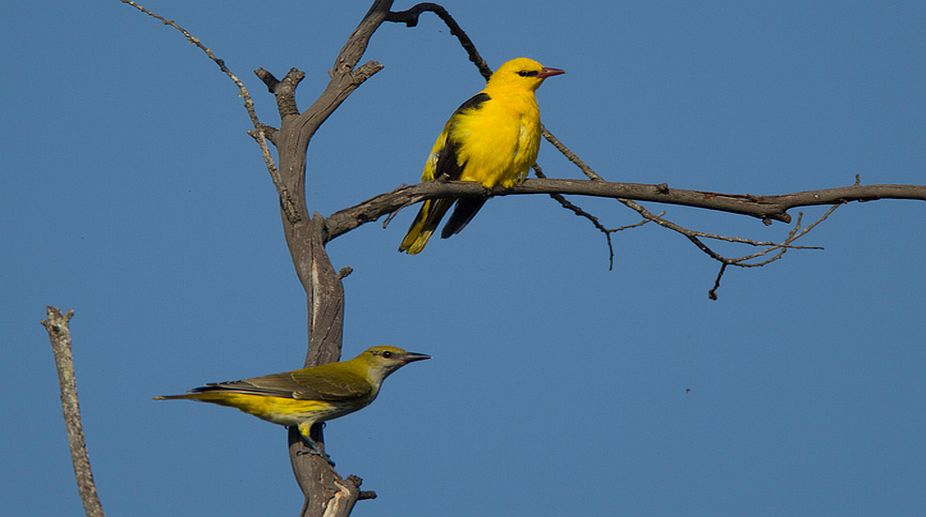Early every summer, when the coral tree (Erythrina Indica) near my compound wall bursts into scarlet flower, two orioles visit my backyard, a cock and a hen, both adult and always in a pair. For the Last four years I have been noticing them, and while I cannot be sure that it is the same pair that comes each year, I think it is. For a few days the birds stay in and around my dusty, unkempt little backyard, and then they go away, till it is March and the coral tree is in bloom again.
The first notice I have of their arrival is the mellow, flatly call of the cock, and the harsh churring noises that both birds make. I hear a raucous scolding and look for the brilliantly yellow cock, and there it is on the neem tree — a moment later I see the more modestly coloured hen, a greenish yellow on top and a speckled grey beneath, with the contrast of black in the pinions less flagrant, and the pair flits over to sip the nectar from the Erythrina flowers. And again I wonder why a bird that is so pure and rich a chrome yellow as the cock oriole should have been called the Golden Oriole, there is nothing golden about it, as there is about the golden pheasant or even the cock iora, less pure in its yellow but then bird names are not always logical.
For years I was a water colour painter, with a deep interest in the interplay of chromatic emphases and the way the plumage of the orioles offsets the unrelieved scarlet of the flowers never fails to intrigue me.
Erythrina flowers, against the almost ultramarine sky of early summer, can appeal only to those with the most robust tastes in colours. The deep scarlet of the flowers lends a warmth and vibrancy to the interspaces of sky between the massed racemes and my eyes feel hurt by the sight. No dark green of mature leaf or deep brown of calvces (as in the nearly related “Flame of the Forest”) to lend relief but the cock oriole’s vivid chrome yellow and black and the almost shrill greenish yellow and the greys of the hen provide the needed complements and contrasts — a quite surprising toning down of too bright colours by too bright colours!
There is a “hill-neem” (Melia Azedarach) beside the ruins of my gate, which is in fruit in March and the orioles eat the ripe fruit with avid relish. They are found of neem fruits too and spend much time in neem trees.
The black eye-streak of the cock is prolonged into a little, sharply acute triangle behind the eye but which token it is clear that these are Indian orioles, and not European oriole, which comes here occasionally as a migrant American “orioles”, incidentally, are birds of a different feather altogether.
In the deciduous forests there is another oriole, the Black-headed Oriole, which is more musical having a regular song, unlike the Golden Oriole — I have often been delighted by its early morning song in summer.
I myself knew the time when orioles were almost common where I live, when my neighbours had great treefilled compounds and the road outside the gate was heavily shaded with banyans and peepuls and portias and other native trees. The compounds of my old neighbours have now been converted into congested housing colonies and the road is no longer shaded. No wonder the tree-loving orioles have gone with the trees.
This was published on 6 June 1965 in the Sunday statesman











